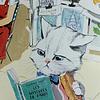Take a photo of a barcode or cover
Graphic: Child abuse, Child death, Death, Emotional abuse, Misogyny, Physical abuse, Sexism, Terminal illness, Grief, Death of parent, Fire/Fire injury, Abandonment, Classism, Pandemic/Epidemic
Moderate: Ableism, Incest, Mental illness
Minor: Panic attacks/disorders, Racial slurs, Racism, Toxic relationship, Antisemitism, Alcohol
Minor: Racism
Graphic: Confinement, Domestic abuse, Emotional abuse, Misogyny, Toxic relationship, Forced institutionalization, Gaslighting
Moderate: Child abuse, Death, Mental illness, Death of parent, Fire/Fire injury, Abandonment, Classism
Minor: Racism, Slavery, Terminal illness
Graphic: Bullying, Child abuse, Child death, Chronic illness, Confinement, Domestic abuse, Mental illness, Racism, Suicidal thoughts, Suicide, Terminal illness, Forced institutionalization, Medical trauma, Schizophrenia/Psychosis , Fire/Fire injury
Moderate: Ableism, Colonisation, Classism
Minor: Racial slurs, Slavery
At its core, the story explores Jane’s relentless quest for home and belonging. Each segment of her life brings her closer to understanding what it means to be true to oneself, despite societal pressures and personal challenges. Brontë’s storytelling is gripping, and her execution of Jane’s character development is superb, showcasing Jane’s strength and moral integrity.
Rochester and Jane’s romance and dynamic are… interesting. I think they are good together. Jane and Rochester are each other’s intellectual equals. They are both smart, and despite the initial power dynamic (with Rochester being older and of a higher social status), they grow to care for each other deeply. Their relationship is fraught with tension, especially after the revelation of Rochester’s existing marriage to Bertha Mason. This twist showcases Jane’s moral fortitude as she refuses to become his mistress, choosing dignity and independence over passion.
While I understand why the twist made sense at the time, I find the addition of Bertha Mason to be a bit strange, especially in the context of current times. The treatment of mental illness and the racial component of her character don’t age well. Bertha Mason, also known as the madwoman in the attic, is Mr. Rochester’s first wife, whom he keeps locked in a room on the third floor of Thornfield Hall. She is a woman from the West Indies of mixed racial ancestry and is, according to Mr. Rochester, a lunatic. Rochester’s narrative of events reveals his initial allure to her beauty and wealth, only to discover her supposed madness post-marriage. His descriptions of her as having “a violent and unreasonable temper” play into the stereotype of the “other” as exotic, mysterious, and ultimately threatening. Since Bertha lacks a voice in the novel, it’s impossible to know if she truly has a mental illness or if Rochester’s biased version distorts her true character.
Jane only marries Rochester after she becomes financially independent and has a sense of family. Rochester, now weakened, tips the balance, making their relationship more equal. This can be seen as Brontë’s way of giving Jane more autonomy, which I appreciate.
The juxtaposition between St. John and Rochester is also interesting. Rochester is passionate, while St. John is driven by principles and morality. Jane’s decision to not choose St. John but still remain financially independent and follow her moral compass shows she values both passion and integrity. She won’t be in a relationship that goes against her principles, which is compelling.
Helen Burns is another intriguing character with her differing views on religion compared to the school’s doctrine. Her submissive and soft nature contrasts with Jane’s tough-willed character, who strives for a better life instead of relying on blind faith. Yet, Jane’s belief in God to guide her makes sense within her journey.
Overall, “Jane Eyre” is a novel worth revisiting for its rich themes and character depth, even if the romance aspect isn’t my preferred genre.
Graphic: Ableism, Child abuse, Forced institutionalization
Moderate: Chronic illness, Death, Racism, Violence
Minor: Classism
Graphic: Death, Domestic abuse, Misogyny, Toxic relationship, Forced institutionalization, Death of parent, Classism
Moderate: Ableism, Child abuse, Confinement, Suicidal thoughts, Grief, Suicide attempt, Schizophrenia/Psychosis , Fire/Fire injury
Minor: Incest, Racism, Religious bigotry, Colonisation
Graphic: Mental illness, Forced institutionalization, Fire/Fire injury, Gaslighting
Moderate: Bullying, Child abuse, Child death, Chronic illness, Confinement, Death, Emotional abuse, Suicidal thoughts, Suicide, Terminal illness, Toxic relationship, Suicide attempt, Classism
Minor: Cursing, Incest, Infidelity, Racism, Sexism, Violence, Blood, Grief, Death of parent, Toxic friendship, Alcohol, Colonisation, Injury/Injury detail
If it were for that I'd give it 5 stars, however the 2nd half is heavily racist, ableist, xenophobic, and classist. Themes of colonialism and religious missions, institutionalisation, grooming (Jane is sadly very much groomed by the men in her life), etc. There is no condemnation of any of this, no revolt against bigotry in the narrative. Therefore, I can't give it a pass for being "of its time", as there are many classics which either resist against or refuse to entertain such bigotry.
Graphic: Ableism, Child abuse, Child death, Confinement, Death, Domestic abuse, Infidelity, Mental illness, Racial slurs, Racism, Sexism, Toxic relationship, Xenophobia, Religious bigotry, Fire/Fire injury, Gaslighting, Toxic friendship, Abandonment, Pandemic/Epidemic
Moderate: Incest, Suicide, Violence, Grief, Schizophrenia/Psychosis , Colonisation, Classism
Minor: Drug abuse, Physical abuse, Suicidal thoughts, Forced institutionalization, Antisemitism, Death of parent
Graphic: Child abuse, Confinement, Infidelity, Mental illness, Forced institutionalization
Moderate: Death, Incest, Suicide, Grief, Death of parent, Fire/Fire injury, Abandonment, Injury/Injury detail
Minor: Racism, Religious bigotry
Moderate: Ableism, Child abuse, Child death, Death, Emotional abuse, Mental illness, Racism, Fire/Fire injury





